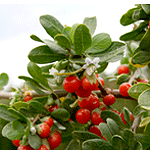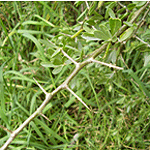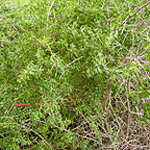African boxthorn
African boxthorn is a rounded, woody, densely branched and very thorny large shrub up to 5 metres high. It reproduces by seed.
Common name:
- African boxthorn
Scientific name:
- Lycium ferocissimum Miers
Other common name:
- Boxthorn
Plant status
Catchment management authority boundaries
Regionally controlled in Corangamite, East Gippsland, West Gippsland, Glenelg Hopkins, Goulburn Broken, Mallee, North Central, North East, Port Phillip and Westernport and Wimmera catchments.
Plant biology

Appearance
Shrub (or bush)
Description
African boxthorn is a rounded, woody, densely branched and very thorny large shrub up to 5 metres high. Reproduces by seed.

Stems
African boxthorn is light brown to grey, erect and much branched. Large spines up to 15cm long occur on the main stems with smaller spines on sides and ends of branches.
Leaves
The leaves of African boxthorn are fleshy and smooth up to 3.5cm long and 2cm wide, ovate to elliptical with short stalks, formed in clusters at the numerous nodes.

Flowers
African boxthorn bears small, scented, white flowers with purple markings, occur singly or in pairs. The main flowering time is October to March, but it can flower at other times.
Fruit
The fruit of African boxthorn is an orange-red, shiny berry containing numerous tiny seeds. Berry approx 1cm in diameter.
Seeds
African boxthorn seeds are light brown to yellow, ovoid or irregular shape, flattened, smooth with small raised dots, 2.5mm long, 1.5mm wide.
Roots
African boxthorn develops an extensive deep, branched taproot.
Growth and lifecycle

Method of reproduction and dispersal
African boxthorn reproduces exclusively by seed which is commonly eaten by birds, seed is viable when excreted. These plants are often found near places where birds have perched such as trees, poles and powerlines. It was widely planted as a hedge plant before its weedy potential was realised. Spread also occurs from contaminated produce and materials.
Rate of growth and spread
African boxthorn is a fast growing invasive species that, if untreated, spreads quickly. Seeds may germinate year round and early root growth is rapid, ensuring young plants are competitive. Plants take at least 2 years to flower, producing flowers and fruit mostly in summer. Some flowering and fruit production occurs at other times of year. Sometimes deciduous in winter, with new leaves and active growth in spring. Broken roots and cut stumps can sprout regrowth.
Origin
Southern Africa
Preferred habitat
African boxthorn prefers dry, light soils invading coastal areas, pastures, neglected areas, roadsides, railway lines and waterways.
Distribution
African boxthorn is widely distributed across Victoria and most abundant in western and northern catchments.
Growth calendar
The icons on the following table represent the times of year for flowering, seeding, germination, the dormancy period of African boxthorn and also the optimum time for treatment.
| Jan | Feb | Mar | Apr | May | Jun | Jul | Aug | Sep | Oct | Nov | Dec | |
|---|---|---|---|---|---|---|---|---|---|---|---|---|
| Flowering | ||||||||||||
| Seeding |
| |||||||||||
| Germination |
|
| ||||||||||
| Dormancy |
| |||||||||||
| Treatment |
| |||||||||||
| New Growth | ||||||||||||
| Active Growth |
|
Impact
Impact on ecosystems and waterways
If untreated, African boxthorn grows to a great size and dense infestations out-compete native plants. It invades watercourses denying animals access to water. It also provides harbour for pest animals such as rabbits and foxes.
Agricultural and economic impacts
African boxthorn invades pasture and watercourses therefore reducing carrying capacity, impeding stock movement and preventing stock access to water.
It provides harbour for pest animals such as rabbits and foxes.
African boxthorn provides a breeding place for pest insects such as:
- fruit fly
- dried fruit beetle
- tomato fly
- house fly.
It is suspected of being slightly toxic to stock although seldom grazed due to long spines. Control of established plants is expensive, often requiring heavy machinery to complete physical removal.
Social value and health impacts
Fruit of African boxthorn may be toxic to humans and its spines can inflict painful injuries. If left untreated, large plants and dense infestations can impede access by people and vehicles.
Management
Prescribed measures for the control of noxious weeds:
- application of a registered herbicide
- physical removal.
Read more about the prescribed measures for the control of noxious weeds
Other management techniques
Cultivation of the soil in which young African boxthorn plants grow may also support its management after implementing the prescribed measures above.